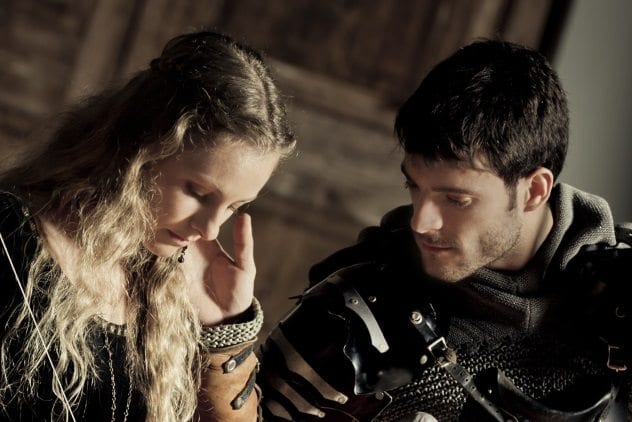 Weird Stuff
Weird Stuff  Weird Stuff
Weird Stuff  Mysteries
Mysteries 10 Tragic Disappearances and Deaths in Joshua Tree National Park
 History
History 10 Ways Childhood Really Sucked in the Old West
 Music
Music 10 Name Origins of Famous Bands from the 1990s
 Religion
Religion 10 Biggest Turnarounds by the Catholic Church
 Weird Stuff
Weird Stuff 10 Unbelievable Times Laws Had Unintended Consequences
 Humans
Humans Ten Historic Women Who Deserve Way More Credit Than They Got
 Movies and TV
Movies and TV 10 Films That Spawned Major Lawsuits
 History
History Ten Times Towns Were Wiped Off the Face of the Earth
 Creepy
Creepy 10 of the Most Disturbingly Haunted Public Houses in the UK
 Weird Stuff
Weird Stuff 10 Niche Subcultures That Are More Popular Than You Might Think
 Mysteries
Mysteries 10 Tragic Disappearances and Deaths in Joshua Tree National Park
 History
History 10 Ways Childhood Really Sucked in the Old West
Who's Behind Listverse?

Jamie Frater
Head Editor
Jamie founded Listverse due to an insatiable desire to share fascinating, obscure, and bizarre facts. He has been a guest speaker on numerous national radio and television stations and is a five time published author.
More About Us Music
Music 10 Name Origins of Famous Bands from the 1990s
 Religion
Religion 10 Biggest Turnarounds by the Catholic Church
 Weird Stuff
Weird Stuff 10 Unbelievable Times Laws Had Unintended Consequences
 Humans
Humans Ten Historic Women Who Deserve Way More Credit Than They Got
 Movies and TV
Movies and TV 10 Films That Spawned Major Lawsuits
 History
History Ten Times Towns Were Wiped Off the Face of the Earth
 Creepy
Creepy 10 of the Most Disturbingly Haunted Public Houses in the UK
Top 10 Tantalizing Facts About Sex in the Middle Ages
Under the heavy influence of the Church, sexual acts during the Middle Ages were policed to an extreme. Despite this state of oppression, people still liked sex. And as you are about to find out, sex during those times was far more interesting than you would expect.
10 Prostitution Was Considered a Necessary Evil
 Prostitution was rife throughout the Middle Ages, and while the clergy weren’t happy about it, they made little effort to stop it. Clerics realized that many men needed this outlet and that a lack of prostitution could do more harm than good. They feared that otherwise, men would corrupt respectable women or, even worse, turn to homosexuality.
Prostitution was rife throughout the Middle Ages, and while the clergy weren’t happy about it, they made little effort to stop it. Clerics realized that many men needed this outlet and that a lack of prostitution could do more harm than good. They feared that otherwise, men would corrupt respectable women or, even worse, turn to homosexuality.
Despite being tolerated, some ordinances reflected the prostitutes’ lowly standing in society. They were obligated to wear certain types of clothing so that they could be distinguished from respectable ladies. In addition, they had to live in certain areas of the city and had no legal standing in a court of law.[1] Brothels were usually thinly disguised as bathhouses or craft shops like embroideries, where women could serve as “apprentices.”
9 Impotence Was Grounds for Marriage Annulment

Many European countries during the Middle Ages had laws that regarded consummation as an integral part of the marriage ceremony. Therefore, if someone was unable or unwilling to procreate, their partner could request an annulment. In addition, an inability to perform the marital duty could result in a trial where the man had to prove that he was physically capable of having sex.
There are dozens of reported cases of impotence trials in medieval times.[2] One of the most famous occurred in 1198, between King Philip II of France and his second wife, Ingeborg, the daughter of the Danish king, Valdemar I. For some reason, Philip hated Ingeborg and didn’t want to have her as queen of France. In a strange twist, the man was actually the one arguing that the marriage had not been consummated, pleading “temporary impotence.”
8 Women Used Contraceptives

Since ancient times, humans have developed numerous techniques to avoid conception. However, until recently, historians believed that usage of contraceptives dropped sharply during the Middle Ages. For starters, the Catholic Church frowned greatly upon them since they saw procreation as a gift from God and the entire reason to get married. Furthermore, scholars believed that women would not be interested in limiting pregnancies due to high infant mortality rates.
However, demographics studies show that pregnancy rates decreased significantly in women over 30, suggesting that they employed various contraceptive methods. Even so, written records of these practices are very scarce due to the Church’s influence and staunch opposition to contraception. Historians believed this created an “oral culture of contraception,” where the “tricks of the trade” were passed down from midwife to midwife. Coitus interruptus was a common birth control method, as were plant-based contraceptives, such as a pessary made out of lily root and rue.[3]
7 The Church Thought Midwives Forced Women Into Sex With the Devil

The late Middle Ages were characterized, among other things, by prolific witch hunts, which saw tens of thousands of people (mostly women) persecuted for witchcraft. Numerous “suspicious” practices could get you declared a witch, and sometimes, this included midwifery.
Things got worse after Pope Innocent VIII issued the papal bull Summis desiderantes affectibus in 1484, acknowledging the existence of witches and approving their prosecution. In response, inquisitor Heinrich Kramer wrote the Malleus Maleficarum, still considered the most important treatise on witchcraft. Kramer claimed that nobody harmed the Catholic Faith more than midwives.[4] He accused midwives of tricking young women into having sex with the Devil and then using unbaptized infants for witchcraft.
Despite the influence of the Malleus Maleficarum, many historians now argue that midwives were rarely accused of witchcraft. Although they are mentioned in other demonology texts, “midwives-as-witches” is regarded as a modern myth brought on by works of earlier historians like Margaret Murray.
6 Clergymen Could Sometimes Get Married

During the Middle Ages, the history of clerical marriages is long and convoluted, with numerous changes occurring over the centuries. At the start of the era, Byzantine emperor Justinian annulled all marriages of members of the Holy Order and declared all of their children illegitimate.[5]
The law of celibacy remained in place for hundreds of years, but it wasn’t always enforced with particular fervor. There was also a distinction made between clergymen who were allowed to marry and married men who were allowed to become clergy. The latter was more common, although typically only if it was their first marriage, and the men were usually expected to show sexual continence once they joined the clerical ranks.
After the Great Schism of 1054, both churches became stricter, and celibacy was enforced again. Clerical marriages were prohibited at the First Council of the Lateran in 1123. These marriages became common again during the Protestant Reformation, as Martin Luther himself was married to Katharina von Bora.
5 Lesbianism Was Considered a Medical Problem

While homosexuality was a “hot topic” during the Middle Ages, attention was usually focused on men. Consequently, there is very little mention of female homosexuality. One of the few medieval laws that specifically target lesbianism comes from the mid-13th-century French treatise Li Livres de jostice et de plet (The Book of Justice and of Pleas). Female sodomy received a similar punishment to its male counterpart: mutilation for the first two offenses and burning for the third.
Lesbianism was regarded as a medical problem brought on by one of two disorders: The first came from the ancient Greek physician Galen, who advised that lack of sex would cause a seed buildup in women’s wombs. The treatment involved an orgasm, generally brought on by a midwife with a hot poultice.[6] The other condition was called “ragadia of the womb.” It was believed that women could develop penis-like protuberances outside their vaginas, which would make them want to have sex with other women.
4 They Used Sex Toys

While sex toys were not invented during the Middle Ages, they were used. Actually, the first sex toys appear in the archaeological record about 30,000 years ago. They existed in various shapes and sizes, made from a wide range of materials, including stone, wood, ivory, tar, teeth, limestone, and even bones. Art from ancient Egypt depicts dildos—for both men and women. And the ancient Greeks—that’s a whole other list right there. Rather than earlier versions of stone or wood, the Greeks made theirs of leather or animal hair, using olive oil as a lubricant.
During the Middle Ages, dildos were commonly made of bread (something the ancient Greeks also did).[7] Their use was generally done in secret as not to incur the wrath and punishment of the Church. Women would bake loaves of bread until they were hard enough to be used as dildos. I can’t imagine how that would’ve worked out. They must have hurt…
3 There Was Cross-Dressing

Cross-dressing hasn’t been regarded as an accepted practice until recently, and it’s still frowned upon in many parts of the world. Unsurprisingly, it was taboo in medieval England, but that doesn’t mean it didn’t happen. One Oxford study presented the cases of 13 women who were cited for cross-dressing in England during the 15th century. Records show that male cross-dressing was just as, if not more, prevalent.[8]
Most cross-dressers tended to be prostitutes who engaged in this practice for their (or their partner’s) sexual desire. Authorities of the time went to great lengths to downplay the pervasiveness of such acts, claiming they were vices from other cultures perpetrated by foreigners.
2 Missionary Was the Preferred Position

The Church considered sex a means to an end for procreation. That’s how missionary became the default position; man-on-top and face-to-face was thought to give the best chances for pregnancy. They feared that any other position might confuse the natural order. Some positions like sex a tergo (from behind) were considered “beastly” and were thought to blur the lines between man and animal.
Church authorities strictly forbade oral and anal sex throughout the Middle Ages. Since there was no chance of procreation, these would have been purely for sexual pleasure, which was viewed as a lustful sin.
As time passed, certain officials became somewhat more progressive. During the 13th century, German friar Albertus Magnus ranked five positions from most to least natural: missionary, side-by-side, seated, standing, and a tergo. While missionary was still the number-one pick, he regarded the others as “morally questionable but not mortally sinful.”[9]
1 There Were Punishments for Every Sexual Sin

When it came to punishments, the Church wanted to make sure they got things right. That’s why the Middle Ages saw the appearance of penitentials—books detailing the rules for penance for every sin under the sun. They came about from priests who started documenting the sins they heard during confession and the penances set for each one.
Unsurprisingly, there were quite a few sins involving sex. There were also quite a few penitentials, but one of the most influential was the Paenitentiale Theodori by Theodore of Tarsus, Archbishop of Canterbury.
According to Theodore, men fornicating with men or with animals had to do penance for 10 years. Women fornicating with women had to do penance for 3 years. Masturbation meant that men had to abstain from meat for four days, while women had to repent for a whole year. This only applied to virgins or widows, as married women earned more penance, of course. Ejaculating seed into the mouth was the worst evil and required penance for life.[10]








